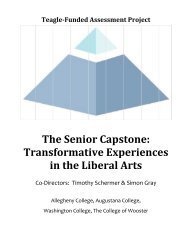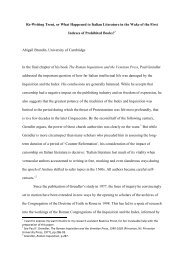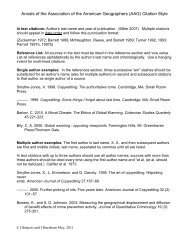Brad S. Gregory - Augustana College
Brad S. Gregory - Augustana College
Brad S. Gregory - Augustana College
You also want an ePaper? Increase the reach of your titles
YUMPU automatically turns print PDFs into web optimized ePapers that Google loves.
English monasteries and friaries, Henry VIII would demonstrate how thoroughly a ruler<br />
could learn this lesson without even having to accept Lutheran or Reformed Protestant<br />
doctrines about grace, faith, salvation, or worship. 48 Assertions of royal authority over<br />
the church were enough, provided they were backed by enough force. By the time Henry<br />
was demonstrating that his will was up to the task, a frightening, polygamist and<br />
communitarian “New Jerusalem” in Münster led by the prophet-king Jan van Leiden had<br />
removed any lingering doubts among secular authorities in Europe about the dangers of<br />
religious radicalism and dissent. 49 Lest rulers‟ negligence permit another Peasants‟ War<br />
or Kingdom of Münster, rebellion inspired by religion had to be suppressed in accord<br />
with the divinely given duty, as Paul put it, to “execute wrath on the wrongdoer” (Rom<br />
13:5). Thus was forged the confessionalizing alliance between those Protestants who<br />
supported and worked with secular political authorities, and those who did not—in short,<br />
the difference between magisterial and radical Protestants. Throughout the sixteenth and<br />
seventeenth centuries, only a carefully controlled and domesticated Reformation would<br />
be permitted to exert a widespread influence.<br />
As a result, Lutheranism and Reformed Protestantism became the great<br />
exceptions of the Reformation—precisely the opposite of how they usually have been and<br />
fifth Birthday, ed. E. I. Kouri and Tom Scott (London: Macmillan, 1987), pp. 158-187; and Walter Ziegler,<br />
“Reformation und Klosterauflösung,” in Reformbemühungen, ed. Elm, pp. 585-614; on Strasbourg in<br />
particular, see Thomas A. <strong>Brad</strong>y, Jr., Protestant Politics: Jacob Sturm (1489-1553) and the German<br />
Reformation (Atlantic Highlands, N. J.: Humanities Press, 1995), pp. 170-174.<br />
48 The classic study of the Henrician suppression of the monasteries is David Knowles, The Religious<br />
Orders in England, vol. 3, The Tudor Age (Cambridge: Cambridge University Press, 1959), pp. 268-417;<br />
see also Joyce Youings, The Dissolution of the Monasteries (London: Allen and Unwin, 1971); Ethan H.<br />
Shagan, Popular Politics and the English Reformation (Cambridge: Cambridge University Press, 2003),<br />
pp. 162-196; Richard Rex, Henry VIII and the English Reformation, 2nd ed. (Houndmills, U. K.: Palgrave,<br />
2006), pp. 45-55; and most recently, Geoffrey Moorhouse, The Last Divine Office: Henry VIII and the<br />
Dissolution of the Monasteries (New York: BlueBridge, 2009).<br />
49 For a recent overview, see Ralf Klötzer, “The Melchiorites and Münster,” in Companion to Anabaptism<br />
and Spiritualism, ed. Roth and Stayer, pp. 217-256; on the immediate reactions to Münster by both<br />
Catholics and magisterial Protestants, see Sigrun Haude, In the Shadow of “Savage Wolves”: Anabaptist<br />
Münster and the German Reformation during the 1530s (Boston, Mass.: Humanities Press, 2000).<br />
21
















